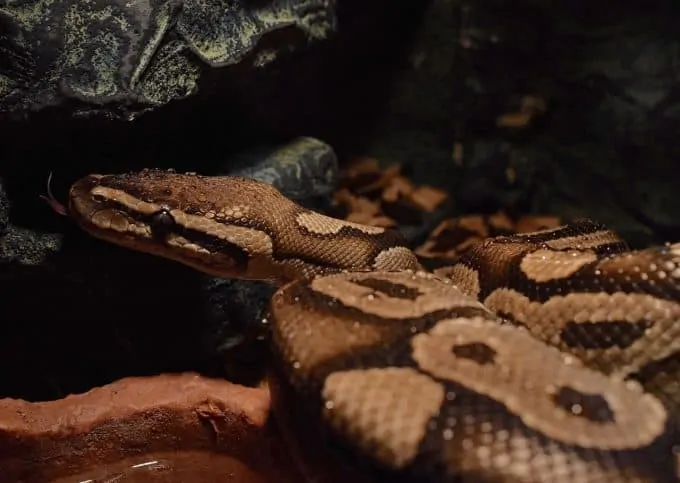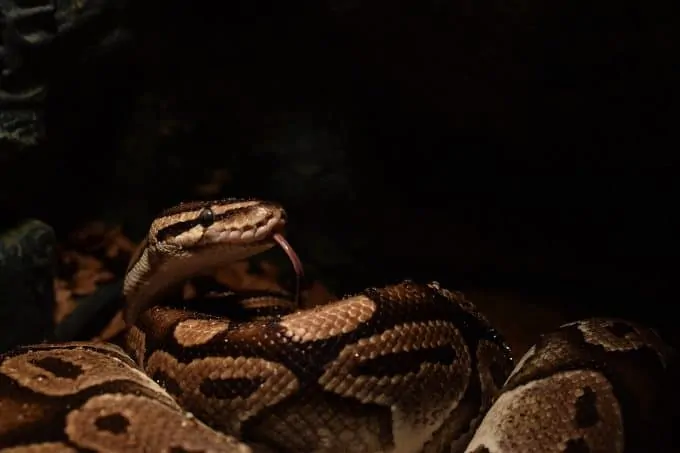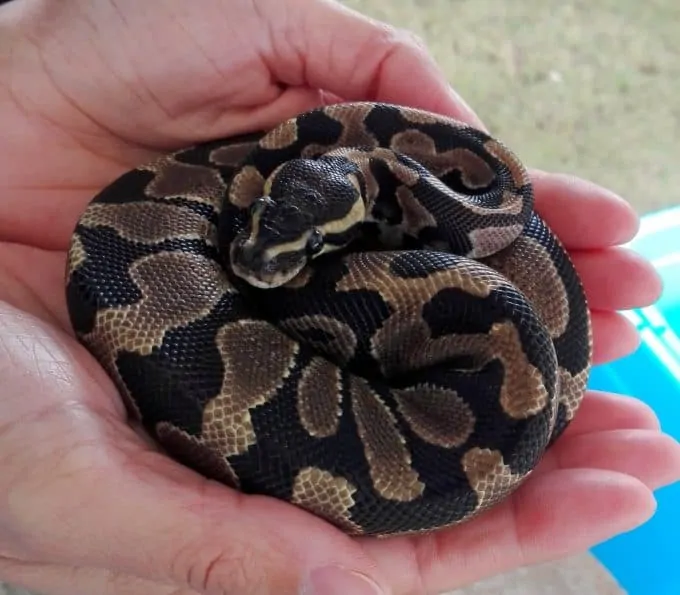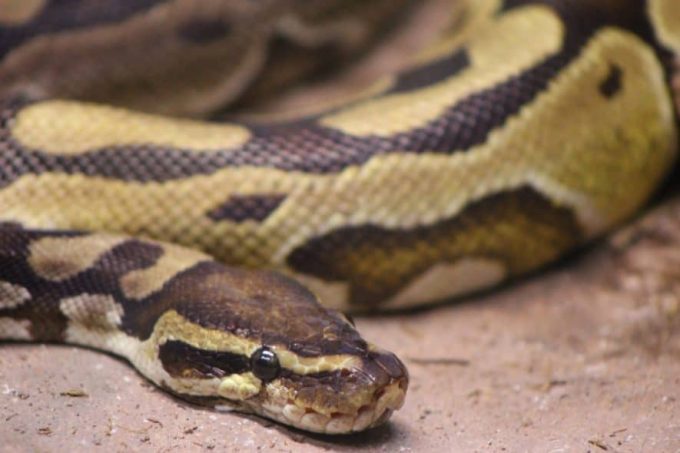Captive-bred ball pythons were occasionally available at that time, but the vast majority of specimens on sale were of the wild-caught, imported variety. These snakes were typically in poor health, and they were often notoriously difficult to feed – no matter what the keeper would try, these frustrating snakes would steadfastly refuse any prey offered.
I experienced this maddening issue firsthand. The ball pythons I kept were challenging to feed, and many of the customers I tried to help experienced similar issues. In fact, the very first ball python I ever owned went more than 6 months without eating before I finally figured out how to get him to accept prey.
We’ll talk about the reasons ball pythons often refuse food below and outline a few strategies for tempting your finicky friend into eating regularly.
Reasons Why Your Ball Python Is Not Eating
In most cases, it will be helpful to begin addressing your snake’s feeding issue by understanding the reasons that ball pythons often refuse food. A few of the most common reasons ball pythons fail to eat include:
Poor Health
Many illnesses will cause a snake to refuse food. Respiratory infections or parasite infestations are two of the most common problems that’ll suppress your snake’s appetite, but anything from dehydration to viral infections can lead to anorexia.
> Further Reading: Ball Python Dying Signs
Improper Habitat
Once you’ve verified that your pet is in good health, you’ll want to turn your attention to his habitat. If you fail to provide your snake with a comfortable environment, you’re almost guaranteed to experience feeding problems.
Seasonal Fasting
If your snake is healthy and his habitat is well-designed, he may simply be fasting. As explained earlier, ball pythons often fast during the dry season, and some individuals also stop eating during the breeding season. Fasting is probably most common among males and wild-caught individuals.
Prey Pickiness
Some ball pythons – particularly wild-caught individuals – exhibit a preference for a given type of prey. Unfortunately, this can cause some specimens will refuse both domestic mice and domestic rats.
How Long Can Ball Pythons Go Without Food?
Many keepers become alarmed when their pet ball python refuses food. In some cases, this can even lead them to do drastic (and potentially dangerous) things like force-feeding their snake. However, these types of extreme measures are rarely necessary, as most ball pythons can survive for quite some time without food.
The exact length of time a ball python can go between meals without dying will vary based on a variety of factors. Nevertheless, it is important to understand that few snakes will actually starve themselves to death, if provided with proper care and offered appropriate food.
Generally speaking, healthy ball pythons can go weeks without eating. And if your snake is an adult who already had a healthy body weight, it would likely take months before he’d start to suffer health problems. A handful of ball pythons have been documented to refuse food for longer than a year without starving.
So, don’t panic if your ball python refuses a meal. Don’t worry at all if your snake refuses a meal or two – many snakes fast occasionally for reasons that only they understand. A two- or three-week fast will rarely be any type of problem.
I generally recommend that keepers begin to implement the strategies below only after their snake has refused food for at least one month. However, there’s nothing wrong with starting earlier – especially in the case of young snakes.
How to Get a Ball Python to Eat?
Now that you understand the primary reasons your snake may refuse food, it is time to put that information to good use by devising methods for tempting him to eat. A few of the most helpful things to do include:
Visit Your Veterinarian
Snakes in poor health will often refuse food. Accordingly, it is wise to make an appointment with your vet anytime your snake refuses food for longer than a few weeks.
Your vet will be able to determine if your snake is suffering from parasites, respiratory infections, or any other health problems that may limit his appetite. Additionally, your vet can tube-feed your vet if necessary, to prevent him from becoming malnourished while you try to address any illnesses affecting him.
Review Your Husbandry Procedures and Habitat Setup
Husbandry problems are one of the most common reasons that ball pythons will refuse to feed. Among other things, you’ll want to verify that you’ve established a good thermal gradient, which provides him with access to a range of temperatures. You’ll also want to ensure that his basking spot is warm enough to keep his metabolism operating properly.
It is also important to provide your ball python with at least one (and preferably several) hiding spaces. Deprived of such, your snake may feel anxious, which will often cause them to refuse food.
Offer Your Ball Python a Different Type of Prey
As mentioned earlier, some ball pythons are very picky about the type of prey they want. Fortunately, you can often convince them to feed by switching up the prey you offer.
For example, you can begin by offering your snake a domestic mouse or domestic rat of a different color. White rodents are very rare in the wild, so try to find dark or multi-colored rodents. Some commercial rodent breeders specifically offer rodents of different colors. If this doesn’t work, you can offer your snake another type of rodents, such as a gerbil, hamster or multimammate mouse.
If neither of these strategies works, you can try to offer your snake a frozen-thawed bird, such as a chick or duckling. Some keepers have also had success using pet species, such as finches.
Use Scent Transfer Techniques
Snakes experience the world largely through their sense of smell, which means that it is often possible to entice them into eating a non-typical prey species, by making it smell like something more appealing. You can often do so by simply rinsing off a domestic mouse or rat, and then rubbing it on the animal you’d like it to smell like.
Experiment with the smells of other rodents, birds, and even lizards, until you find one that works. Gerbils are one of the most promising species to try, but hamsters and finches may also yield positive results.
Presentation Problems
You may have to alter your presentation to tempt some ball pythons to eat. Shy ball pythons, for example, may become intimidated if you move the feeder rodent too aggressively. On the other hand, some ball pythons seem to respond best when they’re gently “teased” with the rodent. You can do this by lightly bumping the snake’s face or neck with the rodent.
In other cases, you may need to animate the rodent in a very realistic fashion. Make it wiggle around a bit, dart from one place in the enclosure to the next, and generally act like a live rodent (just do so with long tongs or tweezers – you don’t want your snake to mistake your hand for prey).
Why Your Baby Ball Python Won’t Eat?
Young ball pythons often fail to feed for the same reasons adult ball pythons do (although they rarely fast due to seasonal changes, as adults often do). Accordingly, many of the same techniques that help entice reluctant adults to feed will also work on neonate ball pythons.
However, there is also one trick that is often helpful for enticing young ball pythons to feed. It is called the plastic cup trick.
Simply put, you’re going to force your snake to remain in close proximity to the intended prey item for several hours (such as overnight). You’re also going to eliminate any sources of stress or distraction, which may make him reluctant to feed.
All you need to do is place your snake in a small, opaque plastic cup (with a few air holes for ventilation), and then add a small, pre-killed prey item to the cup (never leave your snake unattended with a live rodent). This trick doesn’t always work, but you’d be surprised at how often it does convince a young ball python to begin eating.
If this strategy works, you can feed your snake a few more times this way, before trying to feed him normally (while in his habitat). If it doesn’t work, try again a few more times before moving on to the other strategies explained earlier.
Bon appétit!
Food-refusing ball pythons are certainly frustrating to work with. In fact, this is part of the reason it is so important to begin with captive-bred individuals – wild-caught individuals are almost always more difficult to feed than their captive-bred counterparts.
But, regardless of your snake’s origin, it is usually possible to convince him to feed by working through the strategies discussed above.
We hope you’ve found this helpful, and that you are able to get your ball python to eat soon. Please share this article with your friends if you’ve enjoyed it and let us know any questions or comments you have below!





11 Comments
My ball head python has refused every feed for over 5 months now what can I do
Hello Devina,
Ball Pythons are known to occasionally refuse food, especially during the winter months. However, a 5-month fast is a bit unusual. First, ensure your snake’s habitat is correct: proper temperature gradient, adequate hiding spots, and the right humidity level. Stress can often lead to feeding refusal.
If the habitat is correct, then try changing the type of food or the way it’s presented. Some snakes prefer pre-killed prey while others prefer it alive. Also consider switching between mice and rats, or changing the color or size of the prey.
If your python continues to refuse food or if it’s losing significant weight, it’s crucial you consult with a reptile veterinarian. Persistent refusal to eat could be a sign of an underlying health issue.
In the meantime, I recommend you read up on “Ball Python Care” to ensure you’re providing an ideal environment.
I got my hatchling BP in late January, and she didn’t eat until 3 weeks in with me, ate regularly for about a month, and now she’s been 5 weeks without eating and down to 100 grams and I’m getting nervous. She’s got 2 hiding places with a third on the way, but should I consult with a vet?
Her temp gradient is high 80s for basking, then low 80s on the cool side, 50% humidity when the humidifier works. I’ve even tried switching from mice to rats (F/T) with no luck.
Hi Kayla,
It’s not uncommon for ball pythons to go off feed, especially during the cooler months, but continuous weight loss can be a concern. It sounds like your husbandry parameters are in line, which is great.
Firstly, ensure the weighing scale is accurate. Minor fluctuations in weight are normal. If she’s indeed losing weight consistently, you might want to check if she’s behaving normally, has clear eyes, a clean vent, and no signs of mites or other issues.
Consider the size and type of prey. Sometimes, switching from mice to rats can be a little challenging. Try scenting the rats with a mouse or using smaller rats.
If she continues to refuse food and lose weight, consulting with a reptile vet would be a good step to rule out any health issues. Also, read our ball python guide to gain more insights.
Remember, patience is key when dealing with a finicky eater.
My ball python is female. I got her as a re-home, and they told me she was 10 months, but I think she was older. She started eating small rats right off the bat. She is just over 4 feet long, and I assume she is in the adult range. She has graduated to medium mice now. She was eating weekly, and the exception was when she was shedding. She has had some difficult sheds in the past that stressed the crap out of us! She generally starts eating again within 1 to 2 weeks of her shed.
In December, I got her a bigger tank. We went from a 40-gallon to a 120-gallon, which will be her final home. She immediately took to it without problems. She shed again last month; it was her first complete shed. I didn’t even realize she had shed until I went to clean her and lifted her hiding spot to find the complete skin balled up with feces. I cleaned all of that up, and she has refused to eat since then. It has been about a month now. I bought her a new hiding spot because her old one was so tight she sometimes got stuck. She seemed to love it and took to it immediately. I figured this was a great time to seal the deal with a rat but nope.
She has only been a month without eating, and I know their eating habits change. I am assuming that she is about 2 years old now. The only difference is that I have been working so much that I haven’t handled her in a while. She is very social when I do and loves wrapping around me. Today I took her out to see if that gets better. Could it be that she is stressed because of NOT being handled?
I lost a baby snake 2 years ago due to not eating, and this is why I wanted an older one. Needless to say, I am starting to freak out. Any advice?
Hi Raven,
Ball pythons, like many other snakes, can go through periods of not eating which can last up to a few months, especially during cooler months, which is natural and typically not a cause for alarm. If your snake is active, doesn’t show signs of weight loss or other illness symptoms (like nasal discharge, wheezing, or lethargy), it’s likely okay.
The move to a new enclosure and a new hide could have induced some stress, even if it doesn’t appear that way. This change in environment may require an adjustment period.
Reduced handling shouldn’t cause a stress-induced refusal to eat, as snakes are generally solitary creatures and don’t require social interaction like some other pets. If anything, less handling reduces stress.
Continue to monitor her weight and behavior closely. If she continues refusing to eat or starts showing signs of illness or continues to lose weight, I recommend consulting with a reptile vet.
As for the shedding issues, increasing humidity during shed periods can help. You can achieve this by adding a moist hide with damp sphagnum moss, misting the enclosure more frequently, or adding a larger water dish.
I have a one year old male ball python who has allways been eating with a good appetite but recently he has refused to eat. The habitat has remained the same way and there hasn’t been any big changes in it. When I show him the F/T mice or rat he just retreats to his cave and sometimes looks like he is spooked by the rat. He is really active during the night and is not interested in food at all.
Hi Brita,
Ball pythons can often go off feed, particularly during the cooler months, and it’s usually nothing to worry about as long as your snake is not losing significant weight or showing other signs of illness. This could last a few weeks to several months.
However, ensure the temperature gradient in the enclosure is appropriate (88-92°F on the warm end and 75-80°F on the cooler end) and that humidity is in the 50-60% range.
Also, make sure the prey isn’t too large (shouldn’t be wider than the snake’s widest part) and that it’s thoroughly warmed up. Try offering food every 10-14 days, as frequent offering can increase stress.
If your snake continues to refuse food for a prolonged period, loses weight, or exhibits signs of illness, consult a vet.
I’ve had my ball python for two years now and he’s never missed a meal. I feed him weekly on live mice. Not once has he refused food, but today he’s just going up to the mouse, smelling it, and then moving to continue trying to escape from the small tub I’ve put him in. I know a lot of ball pythons refuse food for no apparent reason, so the only reason I’m worried is that he’s never refused food for two years and now suddenly he’s not interested… not sure if that matters. Do they do it randomly all of the sudden when they’re adults?
Hi Tirz,
It’s possible that your ball python has suddenly stopped eating due to a change in its feeding place. It may be feeling more comfortable and safe in its enclosure, so you might want to try feeding him there instead.
Make sure the environment is conducive for feeding, with plenty of hiding spots for keeping it secure and without any disturbances.
You could also try changing the type of food you offer, as some ball pythons prefer different diets. This could be an interesting way to further investigate why your python has suddenly stopped eating.
Good luck!
My BP prefers F/T prey because she seems to get intimidated by live prey. I literally thaw a frozen gerbil for a few hours and stick it in her enclosure one night a week and I wake up and it’s gone! I’ve seen her eat it before too and she just slithers out, opens her mouth, swallows it and goes back into her hide – doesn’t even waste energy striking at it! She’s too easy.
She does go off feed occasionally though, seemingly for no reason at all, maybe once or twice a year. If she doesn’t eat one week, I’ll try again in two weeks, if she refuses again, I’ll try again in three weeks and usually by then she’s very hungry and gets right back on schedule.
When I first got her, she had trouble striking her prey because her substrate would get in her mouth, so I switched to reptile carpet and that did the trick. It’s definitely important to find the right environment for your snake and make sure you don’t touch a thing once you get it perfect! LOL